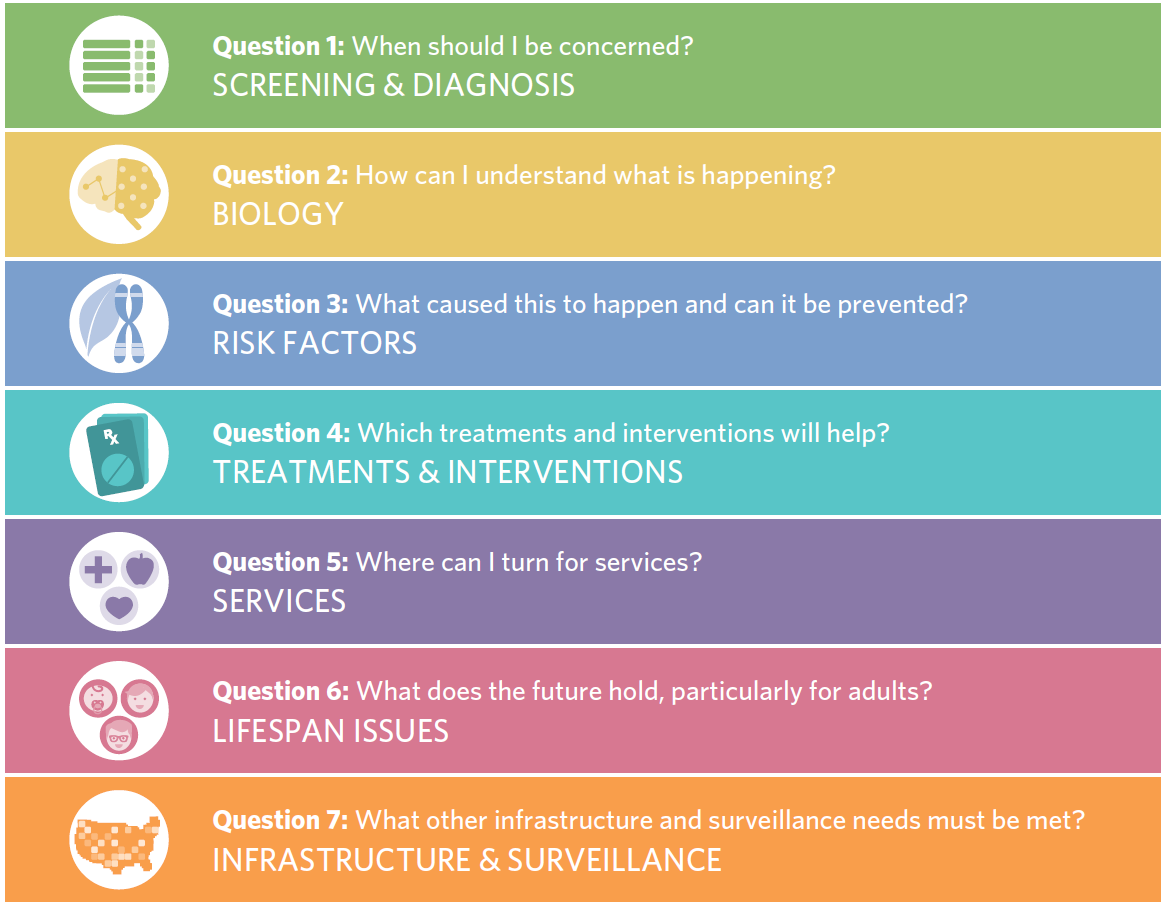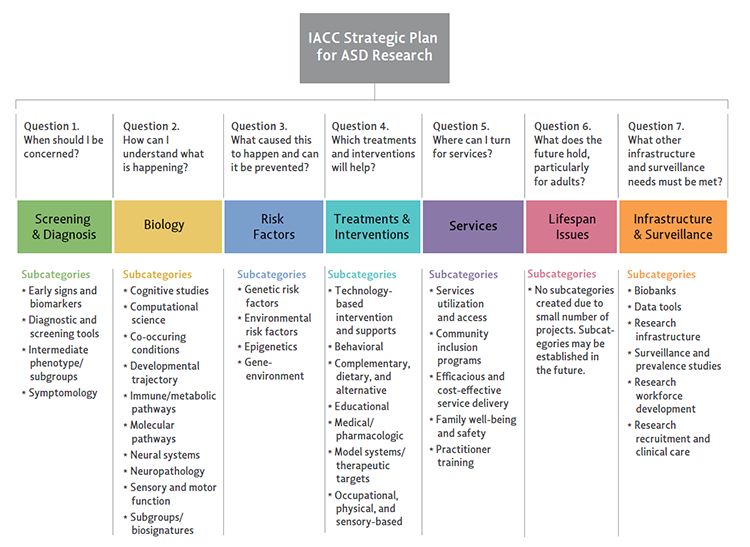Portfolio Analysis Report
IACC Autism Spectrum Disorder Research
2014-2015
In 2009, the Interagency Autism Coordinating Committee (IACC) launched its Strategic Plan for Autism Spectrum Disorder Research, providing a framework to guide the efforts of Federal and private funders of autism research. The IACC Strategic Plan, developed with extensive input from a broad array of Federal and public stakeholders, organizes research priorities around seven general topic areas represented as consumer-focused “questions.” The questions are divided further into research objectives that address key research needs, gaps, and opportunities identified by the Committee. Each objective includes a recommended budget that serves as an estimate of how much the Committee projects it might cost to conduct the research-related activities described. The IACC Strategic Plan was updated in 2010 and 2011, leading to a total of 78 objectives on autism research.
Following the development of the IACC Strategic Plan, the Office of Autism Research Coordination (OARC) – the office within the National Institutes of Health (NIH) that manages the activities of the IACC—began issuing a series of IACC Autism Spectrum Disorder (ASD) Research Portfolio Analysis Reports to provide the IACC with comprehensive information about the status of autism research funding among Federal agencies and private research organizations in the U.S. The reports align data on individual research-related projects with objectives in the IACC Strategic Plan, providing an accounting of how much funding has gone toward support of projects related to Strategic Plan objectives and highlighting trends. This information has been used to help the IACC in their efforts to monitor ASD research efforts and track progress made each year toward achievement of objectives in the IACC Strategic Plan for ASD Research. The 2014-2015 IACC ASD Research Portfolio Analysis Report, in addition to information on progress made toward each of the 78 objectives in the IACC Strategic Plan in 2014 and 2015, also provides an analysis of progress that was made over the eight-year period from 2008-2015. The 2014-2015 Portfolio Analysis Report is the last portfolio analysis measuring these objectives, with a new IACC Strategic Plan and objects forthcoming.
To accompany the IACC 2014-2015 ASD Research Portfolio Analysis Report, detailed Federal and private organization project data are available in the Autism Research Database (ARD), a database accessible via the IACC website (https://iacc.hhs.gov/funding/data/). This database provides stakeholders with a centralized place from which to gather valuable information about ASD research that can support their efforts to serve the autism community.
The IACC Strategic Plan Questions and Corresponding Research Areas
The Office of Autism Research Coordination (OARC) requested 2014 and 2015 autism-related research project and funding information from several Federal agencies and private organizations, including the annual budget for each project and its relevance to the seven critical questions/chapters of the 2011 IACC Strategic Plan for ASD Research, illustrated below (Figure 1).

Figure 1. The research areas corresponding to the seven questions of the 2011 IACC Strategic Plan for ASD Research are represented by the icons to the left of each question.
Subcategory Classification
In 2010, OARC introduced the subcategory classification system (Figure 2) to the IACC Portfolio Analysis Report to help the Committee and other readers of this report better understand the types of research encompassed by the projects in the research portfolio — especially those projects that are categorized as outside the objectives of the Strategic Plan but within a question’s research area. For the subcategory analysis, each project in the 2014-2015 Portfolio Analysis Report was assigned to a subcategory based on the research area it addressed. The application of subcategory coding to projects in the portfolio helped to break the portfolio into easy-to-understand topical areas. For example, within Question 1 (Screening and Diagnosis), the projects were divided into four subcategories: Diagnostic and screening tools, Early signs and biomarkers, Intermediate phenotypes/Subgroups, and Symptomology.
Figure 2. A subcategory classification system was created to allow an understanding of the autism research portfolio based on simple research topics that are relevant to each of the IACC Strategic Plan questions. Appendix D provides detailed definitions of the subcategory research areas.





